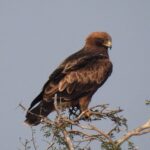Booted eagles (Hieraaetus pennatus) are medium-sized birds of prey that can be found in southern Europe, North Africa, across Asia, and in western South Africa and Namibia. They have a wide distribution in the Palearctic and southern Asia, with a small, disjunct breeding population in south-western Africa. The species is mostly migratory, with northern populations spending November to February in Sub-Saharan Africa and South Asia, while the small southern African populations are sedentary.
Preferred Nesting Habitat of Booted Eagles
Booted eagles prefer wooded, often hilly countryside with some open areas for breeding. They nest in rocky, broken terrain but migrants will use almost any type of habitat other than dense forest. In southern Africa, booted eagles breed strictly on rocky cliffs in ravines and gorges, but evidence has been found of birds nesting in trees such as Euphorbias.
Nest Construction and Breeding Cycle
 Image source: Booted eagle By Dr. Raju Kasambe
Image source: Booted eagle By Dr. Raju Kasambe
The booted eagle’s nest is built from sticks and lined with green leaves in a tree or on a crag, or it takes over the disused nest of another large bird such as a black kite or grey heron. The female incubates the egg for around 45 days, and after hatching, she guards the nest and the young while the male provides all the food. The chick fledges after 70-75 days.
Booted Eagle Breeding Locations
In South Africa, booted eagles are known to breed in the south-western Cape region, arriving in early August, laying eggs in September, and leaving in March of the following year. From about April to July, the birds migrate northwards, some possibly overwintering in Namibia. A small breeding population in Northern Namibia has also been observed. The third group is a non-breeding population thought to migrate south from Eurasia and North Africa in summer, however no empirical evidence of this has been documented.
Hunting Behavior of Booted Eagles
Booted eagles hunt small mammals, reptiles, and birds. They are known to locate their prey while being perched nearby and catch them from a super-fast, almost vertical swoop from above.
Conservation Status of Booted Eagles
In terms of conservation status, the booted eagle is classified as Least Concern (LC) by the International Union for Conservation of Nature (IUCN). However, the species faces threats such as habitat loss and degradation, collision with power lines, and persecution, particularly in the Mediterranean region.
Key Facts about Booted Eagles’ Nesting Habits
| Fact | Description |
|---|---|
| Preferred Nesting Habitat | Wooded, hilly countryside with open areas; rocky, broken terrain; occasionally in trees |
| Nest Construction | Stick nest lined with green leaves, or takes over disused nest of another large bird |
| Breeding Cycle | Female incubates egg for 45 days, chick fledges after 70-75 days |
| Breeding Locations | South-western Cape region of South Africa, Northern Namibia |
| Migration Patterns | Northern populations migrate to Sub-Saharan Africa and South Asia, southern African populations are sedentary |
In conclusion, booted eagles are adaptable birds that can nest in a variety of habitats, from rocky cliffs to trees, as long as they have access to their preferred prey and suitable nesting sites. Their breeding and migration patterns vary across their wide geographic range, but they face ongoing threats to their populations that require conservation efforts to ensure their long-term survival.

